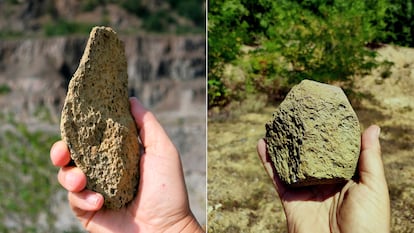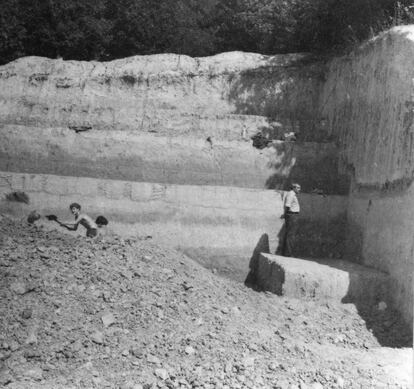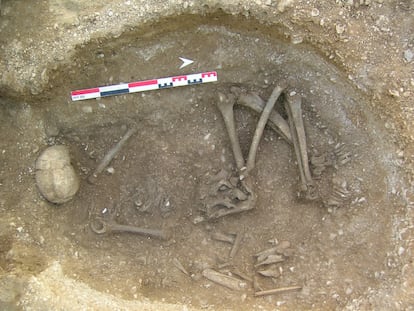Europe’s oldest traces of humans have been found in Ukraine, far away from Russian bombardments
Stone tools carved 1.4 million years ago shed light on the route of the first hominids to set foot on the continent

Long ago in what is now western Ukraine, a starving human sought to eat a piece of carrion, or break into a bone to get at its nutritious marrow. They picked up a stone and began to beat it, until they managed to break off a piece, finally obtaining their desired snack. Such was the technology in Paleolithic times.
That stone was buried and forgotten, until a group of young people working for an archaeologist named V.N. Gladilin unearthed it in the 1980s. They knew immediately that it was the most primitive human utensil they had ever seen, but were unable to ascertain its exact age.
One of those boys was named Vitaly Usik, and today he is a 63-year-old veteran archaeologist who fled his native Ukraine at the beginning of the war. After four years of research, two of them during wartime, a revolutionary technology that uses starbursts as a geological chronometer has shown that the tools were carved some 1.4 million years ago. That makes them the oldest in Europe, and their creator, likely one of the first humans to populate the continent.
The finding sheds light on how early humans, Homo erectus, left Africa and came to Europe. The study, published today in Nature, one of the world’s leading science journals, marks the triumph of a lifetime for beleaguered Ukrainian scientists, many of whom have been forced to leave their country. Usik currently works at the Institute of Archaeology in Brno, Czech Republic, but his colleague Natasha Gerasimenko continues to teach at the Taras Shevchenko National University in Kyiv, in defiance of Russian bombardments. Researchers from four other European countries also authored the paper.
“For a long time, the study of human evolution on our continent has been centered in France and Spain, while we continue to know almost nothing about Eastern and Central Europe,” explains Roman Garba, archaeologist and researcher from the Czech Republic’s Institute of Physics and co-author of the report. “Our discovery shows that the first human beings arrived in Europe from the southeast and probably entered by following the Danube river.”
The Korolevo site has been spared the terror and destruction of the war in the Ukraine thanks to its location. “It is just a few kilometers from the border with Romania and Hungary, two NATO countries; not a single bomb has fallen on it since the war began,” says Garba. In the summer of 2023, the researcher traveled to Korolevo, which is located alongside quarries that are still in operation, to preserve the site and look at the areas in which the tool was found in the 1980s.
Supernovae are explosions of dying stars. The cataclysms produce cosmic rays that travel throughout the universe at the speed of light. When they reach the Earth, they impact minerals and generate radioactive compounds. Using a particle accelerator, it is possible to establish the number of cosmic rays a sample has received and determine its age. This practice, called cosmogenic nuclide dating, is carried out at Helmholtz Center accelerator in Dresden-Rosendorf, Germany. It estimated that the Korolevo tools were 1.4 million years old, with a margin of error of 100,000 years in both directions.

During that period, Europe was experiencing a certain abundance. Huge glaciers the size of entire countries were retreating north, leaving open territory that was prime for the arrival of mammoths, hippopotamuses, saber-toothed tigers, giant hyenas and other megafauna. Likely forced into hiding, and in a constant state of terror and hunger, the first humans followed in the beasts’ footsteps in order to take advantage of the carrion they left in their wake. They did not yet know how to make fire, they had a much smaller brain than ours today, but they were walking upright. They had managed to leave Africa some two million years prior, and got as far as the island of Java, some 500,000 years later.
Erectus is the human species that survived longest on this planet. They have always been considered an Asian species, because most of their remains have appeared on that continent. Africa is seen as the home of its ancestor, Homo habilis, so-called because of their ability to make crude stone tools, not unlike the ones found in Korolevo. Their path throughout Europe is much less certain.
In August 2005, a spectacular heavy-browed, primitive skull was painstakingly unearthed in Dmanisi, Georgia. It proved that erectus had been in this area as early as 1.8 million years ago. The next closest fossil traces were, mysteriously, found at the other end of the continent, in the legendary Sima del Elefante (Pit of the Elephant) of the Atapuerca Sierra in Burgos, Spain, and are from 1.2 million years ago. The Korolevo site now fills the temporal and geographical gap between these two points.
“It’s a strategic site, from a Paleolithic view point,” explains Usik, whose doctoral thesis was based on his work at Atapuerca. “It is on a high ground from where humans could make out the movement of animals. There is a rich reservoir of volcanic stone from which to make tools, and abundant water. Thanks to this new dating technique, we have been able to go from saying that the tools were relatively old to determining the date when the first humans arrived at this site and in Europe in general,” he says.
The tools are currently being stored in the cellars of the National Archaeological Museum in Kyiv, along with the rest of the collection’s pieces, in order to protect them from bombings. Researchers have asked the European Union for a million-dollar grant to excavate again in Korolevo to find more lithic remains. The soil is too acidic to preserve human fossils, Garba believes.

Expectations are now focused on the Atapuerca site, where in the summer of 2022, a fragment of a face that could be up to 1.4 million years old was found, which would make it the oldest human fossil in Europe, although it has not yet been precisely date. The remain has been baptized Pink, likely a tribute to one of its discoverers, Rosa “Pink” Huguet.
María Martinón-Torres, director of Spain’s National Center of Human Evolution, emphasizes that the Korolevo study is “robust and important, because it adds to the list of the few sites in Europe that can solidly document the presence of humans prior to one million years ago.” She continues, “Atapuerca remains the only site that, in addition to [lithic] industry, also provides human remains that can help us determine the protagonists of these early incursions. The authors suggest that because of the chronology, it could be Homo erectus, but we will have to wait for Pink’s analysis to be able to solve that mystery,” she adds.
Huguet, one of the leaders of the Sima del Elefante excavations, says, “We hope that Pink’s work and all its context will be published following this summer, at the latest.” The finding at Korolevo, she adds, “is magnificent news,” and underlines that it is the farthest north point at which such human remains have been located. Atapuerca and Dmanisi are much further south and make more sense as climatic refuges in times of glaciation.
This supports the theory that humans did not arrive in Europe all at once, but rather, in successive waves that took advantage of periods of about 40,000 years between glaciations. When the cold returned, they either died out or fled south again.
It is thought that our own species, Homo sapiens, emerged in Africa about 200,000 years ago, likely from Homo erectus. Our species left Africa several times, probably taking advantage of warm periods. All current inhabitants of the planet descend from one of those waves, which left the African continent about 70,000 years ago.
The remains of erectus are becoming so abundant and distinct that “we may have to sharpen our approach” and being naming new species in order to differentiate certain populations from one another, says Juan Luis Arsuaga, the co-director at Atapuerca. What he does not doubt is that the path through Europe included the recent find in Ukraine: “Surely, the route they followed went by there.”
Sign up for our weekly newsletter to get more English-language news coverage from EL PAÍS USA Edition
Tu suscripción se está usando en otro dispositivo
¿Quieres añadir otro usuario a tu suscripción?
Si continúas leyendo en este dispositivo, no se podrá leer en el otro.
FlechaTu suscripción se está usando en otro dispositivo y solo puedes acceder a EL PAÍS desde un dispositivo a la vez.
Si quieres compartir tu cuenta, cambia tu suscripción a la modalidad Premium, así podrás añadir otro usuario. Cada uno accederá con su propia cuenta de email, lo que os permitirá personalizar vuestra experiencia en EL PAÍS.
¿Tienes una suscripción de empresa? Accede aquí para contratar más cuentas.
En el caso de no saber quién está usando tu cuenta, te recomendamos cambiar tu contraseña aquí.
Si decides continuar compartiendo tu cuenta, este mensaje se mostrará en tu dispositivo y en el de la otra persona que está usando tu cuenta de forma indefinida, afectando a tu experiencia de lectura. Puedes consultar aquí los términos y condiciones de la suscripción digital.
More information
Archived In
Últimas noticias
Most viewed
- Oona Chaplin: ‘I told James Cameron that I was living in a treehouse and starting a permaculture project with a friend’
- Sinaloa Cartel war is taking its toll on Los Chapitos
- Reinhard Genzel, Nobel laureate in physics: ‘One-minute videos will never give you the truth’
- Why the price of coffee has skyrocketed: from Brazilian plantations to specialty coffee houses
- Silver prices are going crazy: This is what’s fueling the rally











































